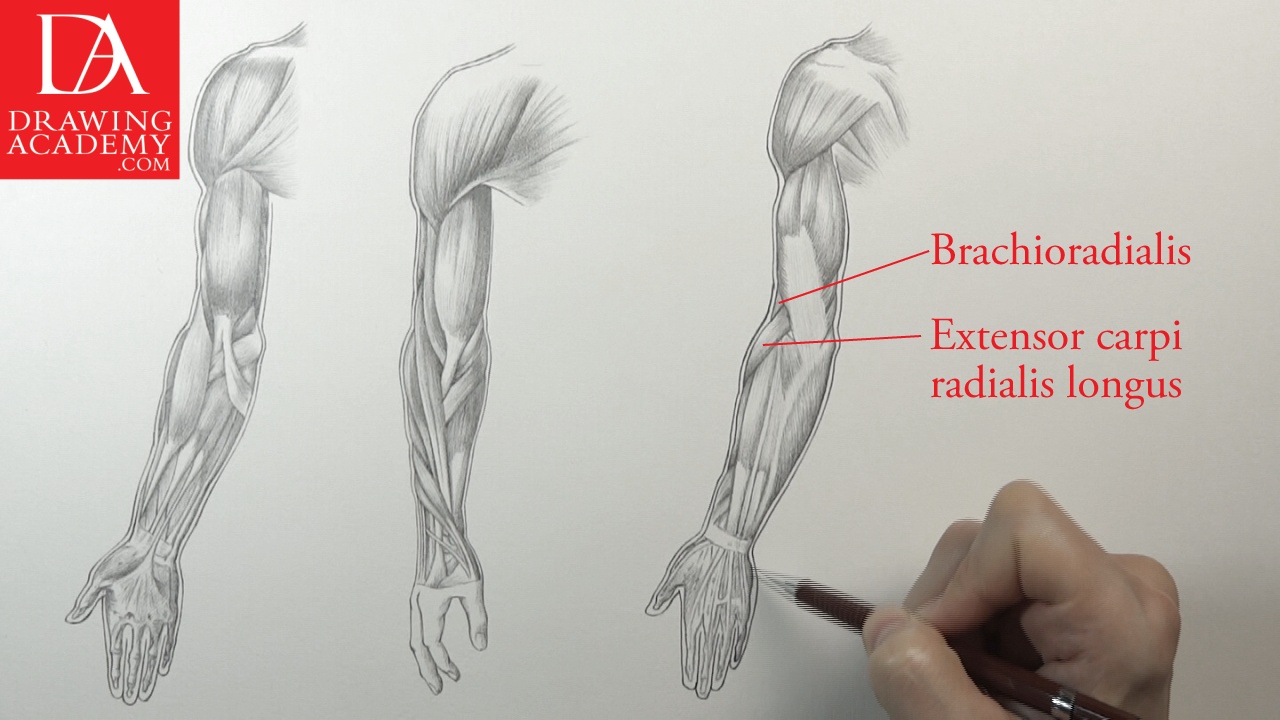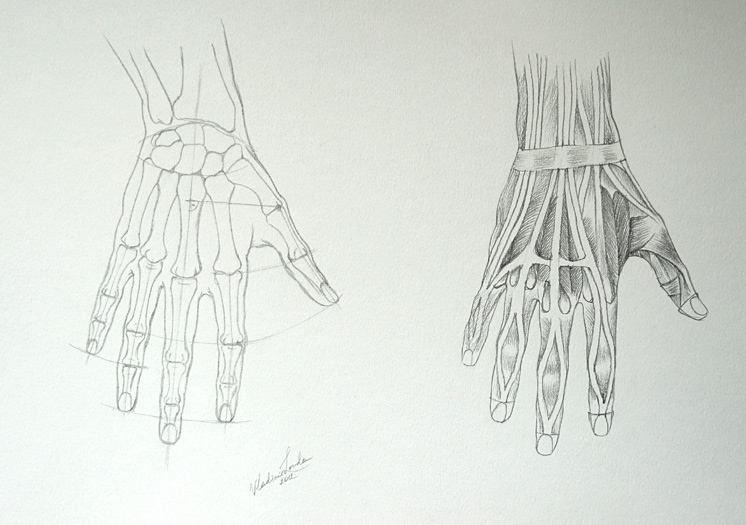Muscles of an Arm – Anatomy for Fine Artists
In this video lesson, you will discover the Muscles of an Arm every figurative fine artist must know to depict human arms realistically.
Enroll in the Drawing Academy Course
Pay once - Enjoy forever!
Only $297
Muscles of an Arm
In this video part of the human’ muscle anatomy lesson, you will discover the main Muscles of an Arm.

The upper limb anatomically consists of the upper arm, which contains the humerus bone, and the lower arm with the radius and ulna bones. The lower arm is also known as the forearm.
There are three main muscles in the upper arm that are easy to identify and every fine artist must now their shapes and locations:
– Deltoid
– Biceps brachii
– Triceps brachii
In addition, there is one less obvious muscle, called the brachialis, which is mostly covered by the biceps brachii and therefore, only a small portion of it can be seen on this drawing. The brachialis muscle helps to flex the elbow joint.

The biceps brachii has two heads, which are called the long head and the short head.
The long head starts from the supraglenoid tubercle of scapula, and the short head from the corocoid process of scapula.
This muscle inserts into the radius bone and the bicipital aponeurosis.
The main action of this muscle is the flexing of the arm at elbow joint. It is also responsible for the supination or rotation of the forearm. The shape of the biceps brachii changes from an elongated form in a straight arm to a compressed and bulky shape when the arm is flexed.
The lower arm’s anterior view presents the following muscles:
– Brachioradialis
– Extensor carpi radialis longus
– Pronator teres
– Flexor carpi radialis
– Palmaris longus
– Flexor carpi ulnaris
– Thenar group of hand
– The hypothenar group of hand
The brachioradialis is a prominent muscle spread between the upper and lower arms. It starts from the humerus bone of the upper arm and inserts into the styloid process of the radius.
The main action of this muscle is to flex the arm in the elbow joint. It also helps to supinate the arm, rotate it, and takes part in pronating the arm. It is most noticeable in such movements of the forearm when operating a screwdriver or corkscrew.
Now, let’s examine the flexor group of Muscles of an Arm.
The flexor carpi radialis begins on the medial epicondyle of humerus and inserts into the base of second and third metacarpal bones on the palmar side of the hand. This strong muscle is responsible for the flexion of the hand toward the forearm.
The palmaris longus takes its origin on the medial epicondyle of humerus and inserts into the flexor retinaculum and palmar aponeurosis. This muscle flexes the wrist joint and bends the hand.
The flexor carpi ulnaris also attaches to the medial epicondyle of humerus and inserts into the carpal bones called pisiform, hook of hamate and the base of the fifth metacarpal. This muscle, together with the flexor carpi radialis and the palmaris longus, flexes the wrist and bends the hand toward the inner forearm.
The pronator teres muscle has two heads, one of which is attached to the medial epicondyle of humerus, and another begins from the medial side of coronoid process of ulna. This muscle inserts into the lateral surface of the radius bone. As reflected by its name, the pronator teres is responsible for the pronation of the lower arm, which is turning the palm backward if the arm is hanging along the torso or turning it down if the arm is bent at the elbow joint.
Now, let’s have a look on the posterior view of Muscles of an Arm.
The muscles seen here are as follows:
– Deltoid
– Triceps brachii
– Brachioradialis
– Extensor carpi radialis longus
– Extensor carpi radialis brevis
– Extensor digitorum
– Extensor carpi ulnaris
– Anconeus
– Flexor carpi ulnaris
– The thumb muscle group
The extensor carpi radialis longus together with the brachioradialis forms the muscular prominence starting just above the elbow. These two muscles go down along the radius bone to the thumb area. The extensor carpi radialis longus is responsible for the extension of the hand at the wrist joint.
The extensor carpi radialis brevis starts from the lateral epicondyle of humerus and inserts into the base of third the metacarpal. This muscle extends the hand at the wrist joint acting together with the extensor carpi ulnaris and extensor carpi radialis longus muscles. Acting in conjunction with the flexor carpi radialis, it performs the radial abduction of the hand.

The extensor digitorum starts from the lateral epicondyle of humerus and inserts into the bases of the middle and distal phalanges of the four fingers apart from the thumb. There is a smaller muscle, called the extensor digiti minimi, which is a detached portion of the extensor digitorum which has its tendon connected to the little 5th finger.
The main action of these muscles is to extend the fingers from the metacarpo-phalangeal joints. Muscle also moves individual fingers at the proximal inter-phalangeal and distal inter-phalangeal joints.
The extensor carpi ulnaris also takes its origin from the lateral epicondyle of humerus and inserts into the dorsal surface of the the base of the 5th metacarpal. Together with the extensor carpi radialis longus, it extends the hand at the wrist joint.
Now, let’s examine the three muscles of the thumb, which form the thumb muscle group.
As viewed on this lateral aspect of the arm drawing, these muscles are:
– Abductor pollicis longus
– Extensor pollicis brevis
– Extensor pollicis longus
All three muscles attach to the dorsal side of the forearm and go obliquely down toward the thumb, where they insert into the base of the first metacarpal, the base of the proximal phalanx of the thumb, and the base of the distal phalanx of the thumb, accordingly. Their tendons create a triangular shape, visible in the ‘thumbs up’ gesture. This shape is called, the ‘anatomical snuffbox’.
The abductor pollicis longus abducts the thumb at the carpo-metacarpal joint, pulling it forward and away from the palm. In addition, it also contributes to the extension of the thumb and the radial abduction of the hand.
Acting together, the extensor pollicis brevis and the extensor pollicis longus, extend the thumb at the carpo-metacarpal and the metacarpo-phalangeal joints.
The extensor pollicis longus extends all the joints of the thumb, making the ‘thumbs up’ gesture.




